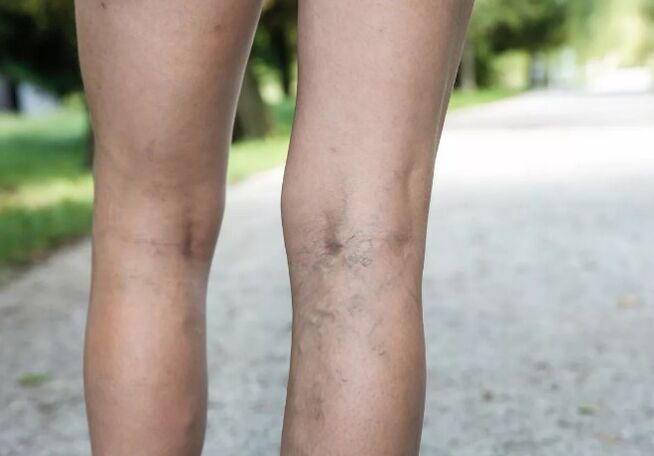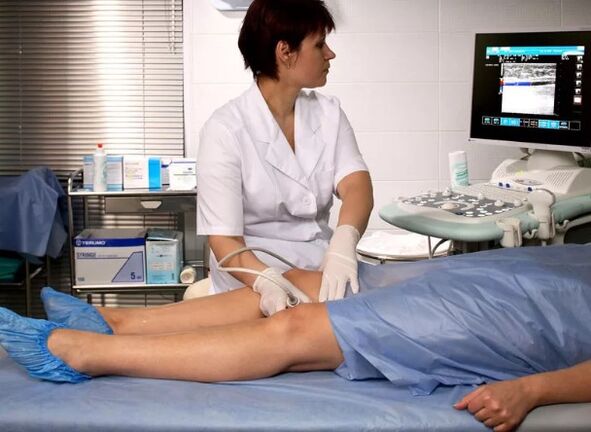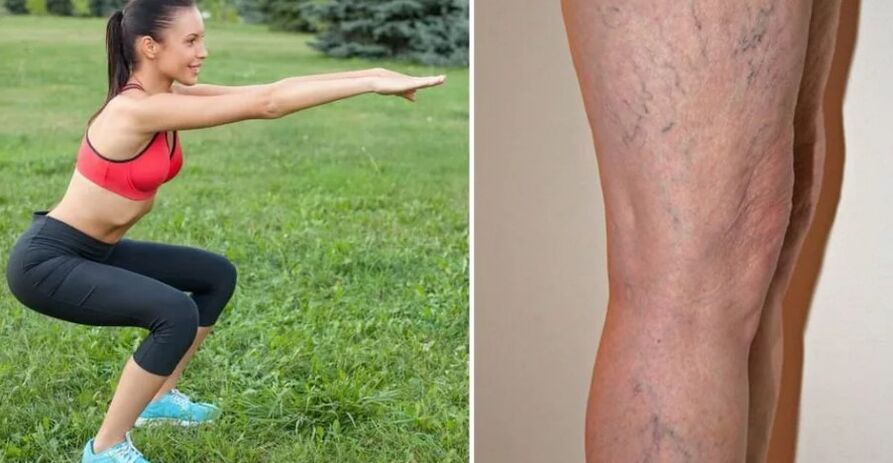Varicose veins on their feet are specific to the spread of the lower extremities, which are accompanied by a general violation of blood flow and valve failure. The spread of veins is characteristic of women and men aged 40 to 60 years.

Development mechanism
The trigger in the development of such pathology as varicose veins is considered a violation of the normal operation of the valve valve with the appearance of blood reflux (reflux - vice versa current). At the cellular level, it is associated with a violation of the balance between some components of the venous wall.
The initial phase is characterized by the presence of genetic and causal factor (extended stay in a seated position, excess weight, injuries and so on). At the same time, the so-called shift parameter, which is a set of blood movement indicators through the vessel, which responds very sensitive to the endotel.
If an irritating factor acts on the wall of the vessel for a long time, leukocytes are firmly secured to endothelial cells, which causes the initial phase of inflammation. The inflammatory process spreads over the venous channel of the lower extremities.
Especially fast, such processes occur in the valves, which are subject to constant, severe mechanical stress. However, inflammation on one leg can be more pronounced than on the other. First of all, it depends on the initial cause of organ damage, for example, on the right leg, varicose veins can be more pronounced among athletes that are emphasis on it.
With valve damage, blood discharge pathologists appear through the mouth of large and small subcutaneous veins. Due to the restart, a surplus flow of blood occurs, a wall of venous veins.
Over time, dynamic vein hypertise develops, which is characterized by reducing pressure in the vessel, as a rule, it happens during walking, to the level of impossibility of insurance of normal blood perfusion through tissue.
Such a process follows the edema, impregnation of subcutaneous tissue with blood cells (red blood cells and leukocytes). Over time, the skin changes its color, swollen, the pigmentation of the skin is reinforced. With the death of cells, which is not rude during medical care, which further leads to the development of trophic rectors.

Classification of varicose veins
Since 2000. A new classification of varicose veins of the lower extremities was developed.
Forms of varicose veins:
- Intradermal or segmental varicose veins without pathological changes;
- Segmental varicose veins with surface refluxes of veins;
- Common varicose veins of surface veins;
- Varicose spread in the presence of deep vein reflux.
Degree of chronic venous insufficiency:
- 0 - does not develop;
- I - the "heavy legs" syndrome, the appearance of the edema;
- II - persistent edema, eczema, lipoderosklerosis;
- III - Trophic ulcer.
Complications of the venous extension of the lower limbs are one of the serious conditions that affect the body: thromboflebitis, trophic ulcers, erizipel, erizipel or bleeding.
Disease classification
By form:
- Varicose veins of the subcutaneous veins of the thighs (starting with the mouth) - descending varicose veins;
- Ascending varicose veins (wen defeat, lower legs and feet, starting from the bottom up);
By clinical groups:
- The first group is a segmentary internal expansion of veins without perforators;
- The second group is the spread of the fragments of the venous trunk;
- The third group is the expansion of the subcutaneous vein of thighs and lower legs;
- The fourth group is a varicose extension of large and small subcutaneous veins with the presence of insolvent perforators;
- The fifth group is spreading surface veins, large and small subcutaneous veins with tissue induction.
The working classification on complications and degree of chronic failure is no different from the standards.
Reasons for developing varicose veins
The exact reason for the development of this pathology is not yet fully clarified, but there are a number of factors that contributes to the appearance of varicose veins:
- Genetic predisposition (rallying gene responsible for the structure of the wall of the vessel is transmitted);
- Changes in the hormone background (pregnancy - during pregnancy, the composition of hormone changes (the amount of progesterone increases and estrogen is reduced), which directly affects the formation of blood coagulation factors);
- Obesity (excess weight leads to a sitting lifestyle, and thus the breakthrough);
- Mellitus diabetes (increased blood sugar damage the wall of the vessel);
- Alcohol abuse (a large amount of blood alcohol is the cause of dehydration and blood condensation);
- severe physical activity;
- Congenital blood disorders;
- Irrational nutrition, dietary errors;
- Unpleasant and close underwear (permanent wear leads to compression of blood vessels);
- Frequent prison (increased intra -abroid pressure leads to severe blood drain in the lower limbs);
- Constant walking in heels (development of stagnation and insufficient muscle movement);
- Increased air temperature (leads to dehydration, condensing blood, and, therefore, to the formation of blood clots);
- Diseases of the cardiovascular system and kidneys;
- medicinal overdose that increase blood coagulation;
- Surgical interventions (blood loss, boat compression).

Varicose vein stages
For this period of medicine development, the three main phases of varicose veins and early phases are different, when the disease is very difficult to notice.
The early stage of the disease is accompanied by swelling, weight, very often ill complain that the legs hurt during a long walk. These are all signs of the beginning of pathology, it is time to start prevention - massages, leg creams, physical activity.
Spreading veins 1. Degree.This phase is characterized by all the above symptoms, which are the Zvešne stars, bruises on their feet, noded veins, visible through the skin. In addition, the appearance of convulsions was observed at night and ignition in the stop area.
Spreading veins 2. Degree.At this stage, the total number of stars and nodes increases, they become more noticeable. The swelling appears, leg pain increases and becomes unbearable to endure it.
Spreading veins 3. Degree.This is the hardest stages that are accompanied by serious legs of the skin leg, becomes dry, lifeless and cracked. The skin of the lower leg becomes dark blue, its structure and pigmentation change.
The third phase is the last when this pathological process can be called varicose veins. Subsequent process development ceases more serious diseases.
It is advisable to consult a doctor in the second phase of disease development, because in time, medical care was not made in serious consequences.
The question immediately appears: "What doctor will go to? ", The answer is simply - a doctor who specializes in the pathology of the lower extremities is called a flectologist.

Symptoms and clinical varicose veins
The leading signs of this disease are numerous extensions of subcutaneous veins, which is why the disease is called. The continuation of the disease usually follows several and unnecessary characteristics.
In this state, patients feel severity in legs, fast fatigue during the movement, sometimes burning and cramps. In addition to pain, the disease is manifested by an edema that develops in the late afternoon, after a hard day.
With long varicose veins, symptoms appear as eczema and itching. Patients scratch their legs, creating unpleasant sensations. Due to the development of skin diseases, the skin above the vein becomes thinner, itchy is constantly combing, which leads to the appearance of the wound.
Over time, the color of the skin in the lower leg becomes bluish. If medical care has not provided in such a situation, the possibility of hyperpigmentation and lipodermasclerosis is possible. A trophic ulcers are developed in even more advanced phases.
Diagnosis of the disease
Varzini extended veins are visible and not armed with armed gaze, no matter how much that condition must be known using instrumental diagnostic methods.
Currently, the Informative method is an ultrasonic methodology of duplex vein scanning. With its assistance, it is estimated by the valve operation, the ability to transverse and the presence of blood clots. The timely study of the vein will avoid heavy and irreversible consequences.
Methods of treatment
How to treat varicose veins? Full girls of varicose veins can only be done with the help of surgical intervention. People who have hereditary predispositions or risk factors recommend visiting a specialist doctor 2-3 times a year, for an ultrasonic vein overview, varicose vein surgery is prescribed in the second phase of disease development.
How much is the operation? The price can be committed differently, all depends on the weight of the disease development.

Surgical treatment
Flebectomy
Indications for vein removal: extensive varicose veins, pathological spread of subcutaneous veins, trophic sores, acute thromboflebitis, spreading deep veins accompanied by general malaimes (tired, dizziness).
Contraindications for disease: coronary heart disease, pregnancy, older age, severe infectious diseases, inflammatory processes.
The advantage of surgical treatment is that this is the only effective method of treatment in advanced forms of disease.
Lack of this treatment: Trauma, anesthesia, a long postoperative period.
Laser therapy (EVVK)
Indications: varicose veins on their feet in combination with various difficult diseases (ischemia, thromboflebitis, asthma, bronchitis, pleuris, ulcers, cholecystones, pyelonephritis, peritonitis, dermatitis and key).
Laser treatment is contraindicated in cases where it is noticed: oncology, liver disease, kidneys, heart (phase decompensation), pregnancy and cerebral sclerosis.
The advantages of such treatment are to resolve the vascular sample, maximum quick procedure, painless and secure, does not require motion observation and attractions.
Disadvantages: Cannot be available at all, expensive, scarring or clarification of the surrounding fabric.
Coagulation of radio frequency of varicose veins
Indications: varicose veins with a small and large subcutaneous vein, a triple ulcer.
Contraindications: acute form of thrombophelbitis, mental disorders, pregnancy.
Advantages: Colorless, hospitalization is not required after surgery, do not interfere with the job.
Disadvantages: expensive process.
Sclerotherapy
Indications: varicose veins in early stages.
Contraindications: pregnancy, breastfeeding, allergic reaction to sclerosant, pure inflammatory processes, thrombosis.
The advantages of this method of treatment are that financial such treatment is cheaper than surgery, rapid recovery, best cosmetic effect.
Disadvantages: Perhaps, entering deep sclerosant veins, is not effective enough with advanced forms of disease.
Medicine treatment
Medicinal treatment helps to improve blood vessels, valve condition, improving blood flow and lymph, and also eliminates inflammation, but not patient healing.
How to treat?

All necessary varicose vein products are divided into:
- Flebotics;
- not -steroid analgesics;
- Hormone medications;
- antithromboid;
- Drugs for aspirin.
Home treatment
Traditional medicine predicts the use of different fats, lotion, tincture, feet or decoctions.
Apple vinegar treatment varicose veins. It is impossible to cure such a disease with folk recipes, however, alleviating symptoms quite real, especially in the initial phase of development. For this, the apple cider vinegar is used for linings, delete, for oral administration or for compresses.
How to avoid disease?
The sedentary lifestyle, standing work, pregnancy is a greater burden, as a result whose disease is developed like varicose veins.
Varicosis in women is the same problem as cellulite, so special creams, lotions, compression stockings and lymphatic drainage are developed.
According to statistics, varicose veins in men are extremely rare, and even if it develops much more slowly.
Can I deal with sports?
Varicosis and running two factors are always walking nearby. The most efficient prevention of vein spreading any of the phases is constant physical voltage: Running, gymnastics, various strength exercises on your feet, bicycles and so on.
There are several simple exercises to improve blood flow and prevent varicose veins:
- Foot rotation clockwise 20 times in each direction.
- Work with your fingers. Enlargement and fingertips 20 times.
- Star at socks, then on heels, and after rolling from heels to socks and back 20-30 times.























